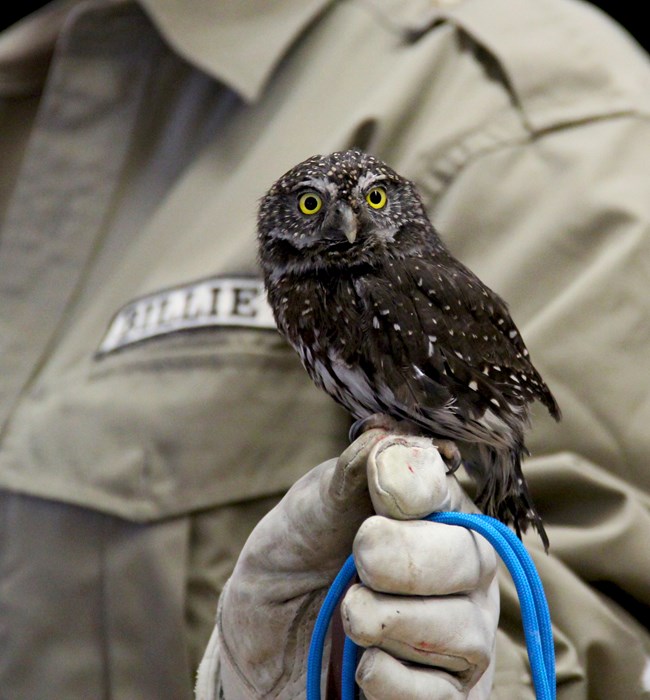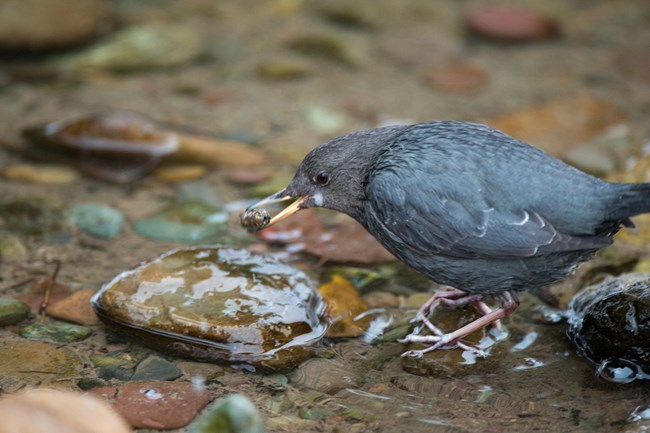Last updated: December 11, 2018
Article
Citizen Science Program Celebrates Year of the Bird
By Ginger Rigdon

NPS/Daniel Lombardi
What do you call a bird in the winter? “Brrr-d!” Winter is approaching Glacier National Park and things are starting to wind down here at the Crown of the Continent Research Learning Center (CCRLC), but 2018 marked a time full of new adventures, interesting public events and joyous celebrations. Among these celebrations was the “Year of the Bird,” a year-long event which commemorates the centennial of the Migratory Bird Treaty Act (MBTA)—the most powerful piece of legislation ever passed to protect North American bird species. Over 150 organizations nationwide joined together to bring attention to the issues that threaten birds and celebrate the numerous conservation efforts to protect and defend them. Entities such as the National Geographic Society, Cornell Lab of Ornithology, National Audubon Society, and the National Park Service have come together to educate and empower the public to take actions to safeguard birds and their habitats.
The CCRLC responded in kind by hosting several events, highlighting the importance of this occasion and informing park visitors on the unique and fascinating world of birds and the history behind this momentous act.
The celebration kicked off in April with a spring bird survey conducted by high school students from around the Flathead Valley. Following the survey, Glacier National Park Wildlife Biologist Lisa Bate led a brown bag presentation for the participating students and the public. A strong advocate for bird conservation, Bate never needs an excuse to sing the praises of birds. Her enthusiasm made her the perfect person to discuss the importance of the Migratory Bird Treaty as well as highlight current research taking place in Glacier on species such as golden eagles and harlequin ducks.
The CCRLC responded in kind by hosting several events, highlighting the importance of this occasion and informing park visitors on the unique and fascinating world of birds and the history behind this momentous act.
The celebration kicked off in April with a spring bird survey conducted by high school students from around the Flathead Valley. Following the survey, Glacier National Park Wildlife Biologist Lisa Bate led a brown bag presentation for the participating students and the public. A strong advocate for bird conservation, Bate never needs an excuse to sing the praises of birds. Her enthusiasm made her the perfect person to discuss the importance of the Migratory Bird Treaty as well as highlight current research taking place in Glacier on species such as golden eagles and harlequin ducks.

NPS/Melissa Sladek
While most raptors that visit the center are rehabilitated and released into the wild, some birds have sustained too great of injuries to be released. If these un-releasable raptors can tolerate the presence of humans with little or no stress, they are used in education programs. Seeing these magnificent birds first-hand and learning about the critical role they play in our ecosystem made this event extra special. Learn more about Montana Wild Wings Recovery’s education birds and the Year of the Bird Event on Glacier National Park Conservancy’s Facebook Live recording.
April’s Year of the Bird event was followed by the park’s first ever Alpine Bird BioBlitz. A BioBlitz is a conservation event used to harness the power of people to survey multiple species in a short time period. Citizen scientists are volunteers who donate their time and effort to assist in gathering data for scientific research. Trained or accompanied by professional scientists, these volunteers reach more sites within a given time frame. This particular BioBlitz was a single day event where 41 citizen scientists, ranging in age and ability, tackled four different alpine sites and made 255 distinct detections consisting of at least 422 individual birds.

NPS/Melissa Sladek
The Alpine Bird BioBlitz provided valuable data on the biodiversity of Glacier’s alpine bird species. Throughout the day, participants made several important sightings, adding to our understanding of species’ locations and abundance. Although participants recorded all birds heard or seen, birders focused on thirteen species of concern to park managers. These particular birds live in the fragile alpine and subalpine zones, making them good indicators of climate change. As temperatures increase, alpine birds may be pushed to even higher elevations, effectively limiting the amount of available habitat to them.
A few highlights of the day include spotting a white-tailed ptarmigan and her chicks, observing a northern goshawk in flight, and hearing the raucous calls of several Clark’s nutcrackers. All in all, the event was a tremendous success and survey methods can be replicated in the future, allowing biologists to monitor any notable changes to Glacier’s alpine bird species.
Additionally, park biologists worked with the CCRLC’s Citizen Science Program to develop a new citizen science project that counts migrating raptors, particularly golden eagles. Glacier’s newly designated Mount Brown Hawkwatch site, located near the top of Mount Brown, is part of an international effort to track long-term raptor migration trends. This new project engages volunteers to assist park staff in monitoring raptors migrating along the Continental Divide. This important North American migration route cuts directly through Glacier National Park, yet little is known about current golden eagle migration trends. Observers gather information on biotic and abiotic factors such as sex, age, color morph, behavior and environmental conditions for all observed raptor species
The impetus for designating Mount Brown as a Hawkwatch site stems from a noticeable decline in golden eagle migration numbers in other Hawkwatch sites outside of the park. During the 1990s, park staff documented nearly 2,000 golden eagles migrating past Mount Brown annually. Recent data, however, collected near Glacier National Park indicates a significant downturn. The reasons for this particular downtick are not completely understood, but a variety of human-caused threats are known to face golden eagles. Among the top culprits are poisoning from lead-shot and lead sinkers, collisions with wind turbines, and the spread of non-native cheatgrass. Cheatgrass is an invasive weed that spreads rapidly, degrading valuable habitat and eliminating food and shelter for the eagles’ prey. By establishing the Mount Brown Hawkwatch site, park managers can discover if golden eagles migrating through Glacier are also declining in numbers. Volunteers who do not wish to make the steep, four-mile trip up Mount Brown can also count migrating golden eagles near Lake McDonald Lodge during the month of October. Look for citizen scientists scanning the mountaintops near Jammer Joe’s Restaurant or huddled together on the sides of Mount Brown. Donning binoculars and spotting scopes and bundled in layers of warm clothing, they’ll be sure to fill you in on the latest raptor sightings—another success story for the Year of the Bird.
A few highlights of the day include spotting a white-tailed ptarmigan and her chicks, observing a northern goshawk in flight, and hearing the raucous calls of several Clark’s nutcrackers. All in all, the event was a tremendous success and survey methods can be replicated in the future, allowing biologists to monitor any notable changes to Glacier’s alpine bird species.
Additionally, park biologists worked with the CCRLC’s Citizen Science Program to develop a new citizen science project that counts migrating raptors, particularly golden eagles. Glacier’s newly designated Mount Brown Hawkwatch site, located near the top of Mount Brown, is part of an international effort to track long-term raptor migration trends. This new project engages volunteers to assist park staff in monitoring raptors migrating along the Continental Divide. This important North American migration route cuts directly through Glacier National Park, yet little is known about current golden eagle migration trends. Observers gather information on biotic and abiotic factors such as sex, age, color morph, behavior and environmental conditions for all observed raptor species
The impetus for designating Mount Brown as a Hawkwatch site stems from a noticeable decline in golden eagle migration numbers in other Hawkwatch sites outside of the park. During the 1990s, park staff documented nearly 2,000 golden eagles migrating past Mount Brown annually. Recent data, however, collected near Glacier National Park indicates a significant downturn. The reasons for this particular downtick are not completely understood, but a variety of human-caused threats are known to face golden eagles. Among the top culprits are poisoning from lead-shot and lead sinkers, collisions with wind turbines, and the spread of non-native cheatgrass. Cheatgrass is an invasive weed that spreads rapidly, degrading valuable habitat and eliminating food and shelter for the eagles’ prey. By establishing the Mount Brown Hawkwatch site, park managers can discover if golden eagles migrating through Glacier are also declining in numbers. Volunteers who do not wish to make the steep, four-mile trip up Mount Brown can also count migrating golden eagles near Lake McDonald Lodge during the month of October. Look for citizen scientists scanning the mountaintops near Jammer Joe’s Restaurant or huddled together on the sides of Mount Brown. Donning binoculars and spotting scopes and bundled in layers of warm clothing, they’ll be sure to fill you in on the latest raptor sightings—another success story for the Year of the Bird.

Chris Peterson photo
Indeed, the Migratory Bird Treaty Act has inspired the first 100 years of conservation efforts. It is our hope that the spirit of the treaty can be embraced for the next 100 years, allowing future generations to enjoy the glint of a golden eagle’s nape as it soars above, or the high-pitched screech of a red-tailed hawk, or the bright colors of a painted bunting foraging for food.
If you are looking for more ways to become involved and soar into action, start by visiting the Citizen Science webpages on the CCRLC website. You can also find additional information about the Year of the Bird on the National Audubon Society’s website.
These programs are made possible by generous contributions from the Glacier National Park Conservancy and its donors.
